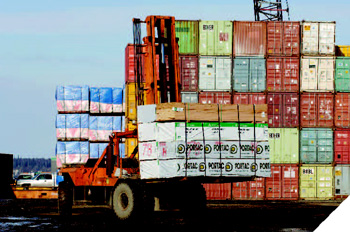Vital Statistics
Company: Spenard Builders Supply
Year founded: 1952
Headquarters: Anchorage, Alaska
Number of locations: 19
Number of employees: 950
2004 gross sales: $300 million
Pro sales percentage: 66 percent
Getting It There
Moving product into and around Alaska requires flexibility, communication, and just about every transport vehicle known to man.
With high seas, pressure-sensitive tundra, and roads covered with ice, getting building materials into Alaska and distributed to jobsites from the Arctic Circle to Kodiak Island can be a dicey procedure. To meet the challenge, Anchorage, Alaska–based Spenard Builders Supply relies on one of the industry’s most diverse pro dealer delivery fleets:
Mastering supply and delivery logistics in Alaska takes hard-earned experience, and Spenard Builders Supply relies on a deep roster of knowledgeable employees, including (standing, left to right) distribution center manager Rich Rapuzzi; vice president of operations Stan Smith; president Ed Waite; vice president of purchasing Rick Thorton; and (seated) rural sales manager Jim Hawes.
Sleeper teams: Two-man trucking teams alternate between driving and resting to keep the pedal to the medal, reaching Alaska from the lower 48 states in approximately two days. Sleeper teams are the fastest and most expensive method of getting materials to Alaska. With fuel costs affecting affordability, SBS uses sleepers sparingly.
Deep-water carriers: Large, ocean-faring steamer ships. SBS relies on Horizon Lines and Totes, the two primary carriers departing from the Port of Seattle. Horizon Lines is container-only, while Totes rolls trailers on and off a five-level cargo hold.
Aquatrain: The Aquatrain is an ocean barge that loads railcars at Prince Rupert, British Columbia, for a six-day journey to Whittier, Alaska, where railcars roll off the ship, onto tracks, and are pulled by standard locomotive to Anchorage and Fairbanks.
Common and contract barge carriers: Three carrier firms—Northland, Sampson, and Alaska Marine Lines—operate common carrier barges from Seattle to various ports in Alaska. Common carriers include freight from a variety of clients while a contract barge is reserved for a single customer. Spenard uses barges to regularly transport material to Anchorage, Sitka, and Kodiak. Two barges a year hit the western coast while ice pack conditions in Barrow leave an open sailing window for only one barge per year.
C-130 Hercules transport planes: Most commonly used for military transport, the C-130 or “The Herc,” as it is more commonly called, can hold up to 42,000 pounds of cargo, but can be a costly alternative to other transport options. Several commercial air cargo companies in Alaska operate C-130s for hire.
Helicopters and bush planes: Helicopters and bush planes are often used for getting materials to regions where available runway space cannot support larger air transports. Additionally, helicopters can be used to carry staged loads from a delivery site to a jobsite that cannot be reached by ground vehicles.
Rollagons: Though rarely used, four- and six-wheel models of the “Rollagon” have carried material between Deadhorse and Prudhoe Bay in northern Alaska to Spenard’s yard in Barrow at land’s end. Rollagons have huge, wide tires for minimal pounds-per-square-inch impact on delicate tundra ecology.
Snowmobiles: Known in Alaska as “snow machines,” snowmobiles are highly effective for transporting material across frozen surfaces and rougher terrain covered with ice and snow. They are commonly used to move construction products from delivery sites to jobsites that are not on an established road system.
The U.S. Mail: Alaska’s “bypass” mail program allows in-state shippers to send 1,000 pounds of material or more to rural Alaska addresses at government-subsidized Parcel Post rates. The material “bypasses” the post office and goes directly to commercial carriers (often airlines) that are paid by the U.S. Postal Service. Spenard also has used regular mail and FedEx for drop-shipping everything from glulam to bricks on jobsites across the state.



